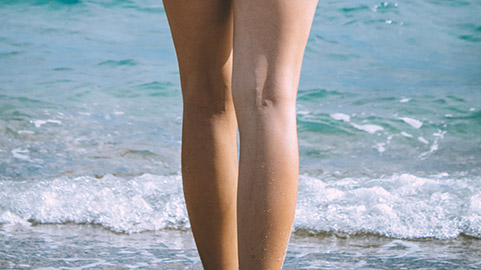
A client with a history of total knee replacement reports a Baker’s cyst. The massage therapist wonders what indications or contraindications are present. But the Baker’s cyst might not be the real issue here.
In this podcast Ruth has a couple of assumptions challenged, which can be fun.
Resources:
Hommel, H., Perka, C. and Kopf, S. (2016) “The fate of Baker’s cyst after total knee arthroplasty,” The Bone & Joint Journal, 98-B(9), pp. 1185–1188. https://doi.org/10.1302/0301-620X.98B9.37748.
Ricci, M. A. and Howe, J. G. (1996) “Baker’s Cyst Causing Deep Venous Thrombosis: A Case Report,” Vascular Surgery, 30(4), pp. 355–358. https://doi.org/10.1177/153857449603000417.
Baker’s Cyst | Swelling Behind The Knee | Treatment and Causes (no date). Available at: https://patient.info/health/knee-pain-patellofemoral-pain/bakers-cyst.
Baker’s (popliteal) cyst: Treatments, symptoms, and causes (no date). Available at: www.medicalnewstoday.com/articles/184714.php.
“Cystic Lesions About the Knee: Practice Essentials, History of the Procedure, Problem.” (2018). Available at: https://emedicine.medscape.com/article/1250593-overview#showall.
Demange, M. K. (2015) “Baker’s Cyst,” Revista Brasileira de Ortopedia, 46(6), pp. 630–633. https://doi.org/10.1016/S2255-4971(15)30317-7.
Frush, T. J. and Noyes, F. R. (2015) “Baker’s Cyst,” Sports Health, 7(4), pp. 359–365. https://doi.org/10.1177/1941738113520130.


This podcast sponsored by:
About Anatomy Trains:
Anatomy Trains is a global leader in online anatomy education and also provides in-classroom certification programs forstructuralintegration in the US, Canada, Australia, Europe, Japan, and China, as well as fresh-tissue cadaverdissectionlabs and weekend courses. The work of Anatomy Trains originated with founder Tom Myers, who mapped the human body into 13 myofascial meridians in his original book, currently in itsfourthedition and translated into 12 languages. The principles of Anatomy Trains are used by osteopaths,physicaltherapists,bodyworkers,massagetherapists,personaltrainers,yoga,Pilates,Gyrotonics,and other body-minded manual therapists and movement professionals. Anatomy Trains inspires these practitioners to work with holistic anatomy in treating system-wide patterns to provide improved client outcomes in terms of structure and function.
Website:anatomytrains.com
Email:info@anatomytrains.com
Facebook:facebook.com/AnatomyTrains
Instagram: instagram.com/anatomytrainsofficial
0:00:00.0 Speaker 1: Ruth Werner's best-selling book, a massage therapist's Guide to pathology, is a highly regarded comprehensive resource that sets the standard for pathology education written for massage therapy students and practitioners. This ground-breaking resource serves up a comprehensive review of the pathophysiology, signs, symptoms and treatment of more than 500 diseases and disorders. Learn more at booksofdiscovery.com.
0:00:33.1 Speaker 2: Anatomy Trains is delighted to announce a brand new dissection live stream specialty class on September 18th, lumbopelvic stability. A one-day layer dissection with Anatomy Trains author Tom Myers and master dissector Todd Garcia. The early bird price of $150 is held until September 10th. After September 10th, the price is $250. Come see the body's actual core for yourself. This course will be provided over Zoom webinar with multiple camera views, live chat and Q&A. Visit Anatomytrains.com to sign up.
[music]
0:01:15.4 Ruth Werner: Hi, and welcome to I Have A Client Who pathology conversations with Ruth Werner, the podcast where I will discuss your real life stories about clients with conditions that are perplexing or confusing.
0:01:28.6 RW: I'm Ruth Werner, author of a massage therapist's Guide to pathology. And I have spent decades studying, writing about and teaching about where massage therapy intersects with diseases and conditions that might limit our client's health. We almost always have something good to offer, even with our most challenged clients, but we need to figure out a way to do that safely, effectively and within our scope of practice, and sometimes as we have all learned, that is harder than it looks.
0:02:02.8 RW: Today's I Have A Client Who story is a nice simple one, sort of... It comes from a massage therapist who posted this in one of the massage therapy groups on Facebook, and they generously gave me permission to share. Can someone send me in the right direction for finding information about Baker's cysts and their contra indications or indications. I Have A Client Who says she believes she has a baker's cyst in her right popliteal region, she has had knee reconstructive surgery on the right knee four or five years ago, and has struggled with extension of her knee and mobility ever since, there's inflammation in both legs, she's in her 70s, what's the best course of action to help her and can I help her? Before I work on her, I would like to have some more information on her condition. I see some cause for concern in this description, do you?
0:03:00.0 RW: Right, so Baker's cysts are pockets of synovial fluid that are suspended from the knee joint capsule or from a bursa on the posterior side of the knee, sometimes they're called popliteal cysts. They usually protrude into a gap between the medial head of the gastrocnemius and the tendon of the semimembranosus so that's on the medial aspect of the popliteal fossa, I don't often get to use a lot of anatomical musculoskeletal terminology these days, so it's kind of fun to revisit these old friends. So there's that Baker's cyst hanging into the knee pit on the medial side, if it gets really big, it can go down the back of the calf deep to the medial gastrocnemius. These cysts are often small and silent, but they can get big enough to interfere with function, especially range of motion inflection, and they can cause asymmetry in the size and shape of the lower leg, and as I hope you know that is always a situation that demands some questions from massage therapists. One of the interesting factors in Baker's cysts is that the pouch often has a one-way valve and this allows fluid to flow into it, but not out, and this is why they rarely spontaneously resolve.
0:04:17.4 RW: There are tons of pictures of Baker's cysts online. They aren't gory and they can be instructive, but I didn't find any really good ones through Creative Commons licensing, so I did not include one in the show notes for today. I do recommend an image search for this though, because you'll see some really great stuff. At this point, you might be wondering, why do bakers get cysts? Is there something about kneading bread or working around ovens that puts this unusual strain on the knee? Should I really make that sour dough loaf tonight? Am I putting myself at risk? Let me put your mind at rest. Baker's cysts have nothing to do with baking, they are named for a 19th century surgeon, Dr. William Morrant Baker, he specialised in bone and joint problems and named the cysts in a paper published in 1885.
0:05:10.4 RW: So who usually gets Baker's cysts? Well, it's usually kids and in children, they tend to resolve on their own or with some ice, maybe a cortisone shot or aspiration, when they happen in adults, it's usually because something's going on with this knee joint, osteoarthritis or rheumatoid or gout, or lupus, or a knee injury, a cartilage tear, a cruciate ligament tear or something like that, when adults get Baker's cysts, they are usually over 40 years old, so we know that fits this client, she's in her 70s and she had a knee replacement on the affected side, probably from osteoarthritis.
0:05:49.6 RW: I started writing this podcast under the assumption that any pre-existing issue with her knee joint capsule would have been resolved with her joint replacement surgery, and I wasn't alone until recently that was the accepted common wisdom that total knee replacement would fix Baker's cysts. Isn't it great to be proved completely wrong? It turns out, according to at least one study published in 2016 that of 102 patients with verified Baker's cysts before knee joint replacement, 87 of them still had Baker's cysts a year after their surgery, and 44% of them still complained of symptoms that limited their function. This study will be in the show notes, of course, isn't it wonderful to have your assumptions just be completely off the rails? Sometimes, not always, it's really kind of fun, and it certainly changed my thoughts about the person in this... I Have A Client Who story. Is it possible for Baker's cysts to become a dangerous problem?
0:06:55.2 RW: Well, maybe, as you will see, if you look at any pictures, sometimes these cysts can get big enough to substantially distort the shape of the leg. It seems reasonable to assume that a large cyst could impair blood flow in the popliteal vein causing a DVT, but this turns out to be really rare.
0:07:14.2 RW: Look at that, another assumption blown; however, it can be difficult to differentiate between a Baker's cyst and a DVT, and if a cyst ruptures, the fluid leaks into any intramuscular space in the lower leg, and that looks a lot like a DVT too. Fortunately, both ultrasound and MRIs are reliable imaging tests that tell the difference. Rarely venography might be used, but that has the risk of damaging the vein, and it's preferable to avoid that if we're already concerned about a DVT. Here's another piece of good news, telling the difference between Baker's cysts and DVT is not our job, hooray. So let's consider the lady at the center of this conversation to review, the therapist says, I Have A Client Who says she believes she has a baker's cyst in her right popliteal region, she's had knee reconstructive surgery on the right knee four or five years ago and has struggled with extension of her knee and mobility ever since. There's inflammation in both legs, she's in her 70s, what's the best course of action to help her and can I help her before I work on her, I would like to have some more information on her condition.
0:08:34.7 RW: Well, what do you think? What do you want to know before you move forward? Here are a few of my questions, does she know for sure it's a Baker's cyst, because if not, she really needs to get evaluated, just in case it's a DVT. We know that she has struggled with extension and mobility since her surgery, is it worse now? That is, is this why she's seeking massage? Truthfully, and here's the answer to this massage therapist's question, massage therapy shouldn't have any significant impact on Baker's cysts. The popliteal fossa is in an area that does not invite deep diving in terms of intrusive massage, so even if the cyst is relatively large, if it isn't having an impact on leg circulation, it really isn't relevant to us. We shouldn't try to pop it. And because of that one-way valve system, safe massage is extremely unlikely to make it smaller.
0:09:30.6 RW: But I am more curious about another issue, what can she tell us about that inflammation in her legs, because for me, that's the key in this decision-making process. If we can ascertain that whatever is happening in this lady's knee is not a DVT, we are still left with wondering what that inflammation is about, I wanna know if that's new, if it's related to anything in particular, what makes it worse or better? And most of all, I wanna know what her normal physical activities include, because those are the variables that would inform my decisions about massage therapy, and until we know more about that, anything more intense than light touch, especially on her legs, is pretty much off the table for me. Am I being too conservative? Let me know what you think.
0:10:23.3 RW: Hey everybody, thanks for listening to, I Have A Client Who, pathology conversations with Ruth Werner. Remember, you can send me your, I Have A Client Who stories to, ihaveaclientwho@abmp.com. That's ihaveaclientwho, all one word, all lowercase @abmp.com. I can't wait to see what you send me and I'll see you next time.
[music]